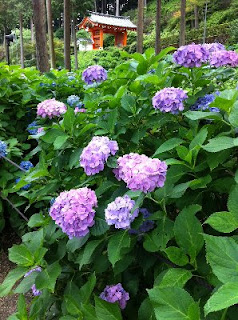They are just windows, but the very
windows.
It may sound a little strange. Sometimes something shows us a spefic meaning.
I think that's it.
It may sound a little strange. Sometimes something shows us a spefic meaning.
I think that's it.
When you enter the main hall of Genkoan temple, you will find two
windows there.One is square and the other is round. The square one is called
"The window of hesitation." and the round one " The window of
enlightment" Do you know why they are called so?
Imagine the shape of square. It has corners. When the corner hits or touches something, it will make a scrach or a flaw. If you have something sharp or pointed in your mind, it easily makes someone's heart get hurt, or causes the world around you to make some troubles. However, if it is round, when it hits something, it won't make any flaws or troubles. The two windows tell us to have a heart like a round window
Imagine the shape of square. It has corners. When the corner hits or touches something, it will make a scrach or a flaw. If you have something sharp or pointed in your mind, it easily makes someone's heart get hurt, or causes the world around you to make some troubles. However, if it is round, when it hits something, it won't make any flaws or troubles. The two windows tell us to have a heart like a round window
Please look upward in that hall, and you
will see a ceiling with some steins. What are they? How did it get them?
It is blood... Look carefully, and you will find some footprints or handprints on it. It used to be floor board of Fushimi castle about 400 years ago. The days were going to see another big civil war to decide the next ruler. Ieyasu ( the first Shogun of Tokugawa Shogunate) and Mitsunari ( the first aid of the former ruler Hideyoshi) were going to start the war. The war took place in Sekigahara. Fushimi castle was in the west of Sekigahara ( in the teritory of Mitsunari army),
The surbordenate warlord of Ieyasu, Mototada Torii, had to stay in the castle to protect the castle from Mitsunari. Ieyasu offered him to leave more worriors for him to help after Ieyasu left there . However, the warlord ( Mototada Torii ) cordially delined Ieyasu's offer, saying "No more unnecessary deaths". He knew he was going to die.
They drank some sake together and spent a quiet time for farewell . Mototada and a small number of warriors bravely fought against Mitsunari army which consisted of 40,000 warriors.. The fight was supposed to end in a few days but, in fact , it lasted for more than 10 days. The protest by Mototada troop against Mitsunari army was so strong that Mitsunari army could not help taking far more time than they had expected to end this fight.
It is blood... Look carefully, and you will find some footprints or handprints on it. It used to be floor board of Fushimi castle about 400 years ago. The days were going to see another big civil war to decide the next ruler. Ieyasu ( the first Shogun of Tokugawa Shogunate) and Mitsunari ( the first aid of the former ruler Hideyoshi) were going to start the war. The war took place in Sekigahara. Fushimi castle was in the west of Sekigahara ( in the teritory of Mitsunari army),
The surbordenate warlord of Ieyasu, Mototada Torii, had to stay in the castle to protect the castle from Mitsunari. Ieyasu offered him to leave more worriors for him to help after Ieyasu left there . However, the warlord ( Mototada Torii ) cordially delined Ieyasu's offer, saying "No more unnecessary deaths". He knew he was going to die.
They drank some sake together and spent a quiet time for farewell . Mototada and a small number of warriors bravely fought against Mitsunari army which consisted of 40,000 warriors.. The fight was supposed to end in a few days but, in fact , it lasted for more than 10 days. The protest by Mototada troop against Mitsunari army was so strong that Mitsunari army could not help taking far more time than they had expected to end this fight.
Motodata
and his followers killed themselves at the last moment, and their bodies
were left there for a while. The floor board was divided
into several parts and now they are used as a ceiling in several
temples so that the monks in those temples and we can pray for
the departed souls.
The
other temples which have such ceilings are Hosen-in temple in Ohara,
Yogenin temple, Shodenji temple, Koshoji temple, Shin-oji temple, Tenkyuin
temple in Myoshinji temple, and Eishunji temple. The Famous ones are
Genkoan, Hosenin temple and Yogenin temple. Actually, at the moment in our
history, there were warriors who fought for Ieyasu by sacrificing their
lives. 

.jpg)





